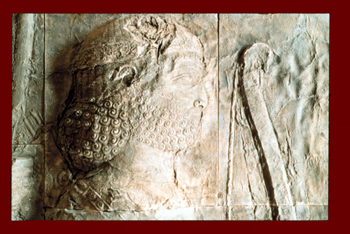Egyptian and Near East Gallery
Like the objects in the exhibition Cavafy’s World, certain items on permanent display in the Kelsey Museum galleries also resonate with some of Constantine Cavafy’s poems. Two such examples from the Egyptian and Near East Gallery are offered here.
Plaster cast of the head of King Darius (also spelled Dareios)
From George C. Cameron’s latex squeezes of sculptural section of the Behistun monument, 1948
Kelsey Museum 1986.10.1
 |
|
Dareios
Phernazis the poet is at work
on the crucial part of his epic:
how Dareios, son of Hystaspis,
took over the Persian kingdom.
(It’s from him, Dareios, that our glorious king,
Mithridatis, Dionysos and Evpator, descends.)
But this calls for serious thought; Phernazis has to analyze
the feelings Dareios must have had:
arrogance, maybe, and intoxication? No—more likely
a certain insight into the vanities of greatness.
The poet thinks deeply about the question.
But his servant, rushing in,
cuts him short
to announce very serious news:
the war with the Romans has begun;
most of our army has crossed the borders.
The poet is dumbfounded. What a disaster!
How can our glorious king,
Mithridatis, Dionysos and Evpator,
bother about Greek poems now?
In the middle of a war—just think, Greek poems!
Phernazis gets all worked up. What bad luck!
Just when he was sure to distinguish himself
with his Dareios, sure to silence
his envious critics once and for all.
What a setback, terrible setback to his plans.
And if it’s only a setback, that wouldn’t be too bad.
But can we really consider ourselves safe in Amisos?
The town isn’t very well fortified,
and the Romans are the most awful enemies.
Are we, Cappadocians, really a match for them?
Is it conceivable?
Are we now to put ourselves against the legions?
Great gods, protectors of Asia, help us.
But through all his distress, all the turmoil,
the poetic idea comes and goes insistently:
arrogance and intoxication—that’s the most likely, of course:
arrogance and intoxication are what Dareios must have felt.
Trans. Edmund Keeley and Philip Sherrard
|
|
|
Limestone funerary relief bust
Palmyra, Syria
Parthian, AD 200–225
Kelsey Museum 1980.1.1
 |
|
Philhellene
Make sure the engraving is done skillfully.
The expression serious, majestic.
The diadem preferably somewhat narrow:
I don’t like that broad kind the Parthians wear.
The inscription, as usual, in Greek:
nothing excessive or pompous—
we don’t want the proconsul to take it the wrong way:
he’s always nosing things out and reporting back to Rome—
but of course giving me due honor.
Something very special on the other side:
some discus-thrower, young, good-looking.
Above all I urge you to see to it
(Sithaspis, for God’s sake don’t let them forget)
that after “King” and “Savior,”
they engrave “Philhellene” in elegant characters.
Now don’t try to be clever
with your “where are the Greeks?” and “what things Greek
here behind Zagros, out beyond Phraata?”
Since so many others more barbarian than ourselves
choose to inscribe it, we will inscribe it too.
And besides, don’t forget that sometimes
sophists do come to us from Syria,
and versifiers, and other triflers of that kind.
So we are not, I think, un-Greek.
Trans. Edmund Keeley and Philip Sherrard
|
|
|
|
|
|